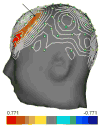Asymmetric prefrontal cortex activation in relation to markers of overeating in obese humans
- PMID: 19426775
- PMCID: PMC2710393
- DOI: 10.1016/j.appet.2009.04.220
Asymmetric prefrontal cortex activation in relation to markers of overeating in obese humans
Abstract
Dietary restraint is heavily influenced by affect, which has been independently related to asymmetrical activation in the prefrontal cortex (prefrontal asymmetry) in electroencephalograph (EEG) studies. In normal weight individuals, dietary restraint has been related to prefrontal asymmetry; however, this relationship was not mediated by affect. This study was designed to test the hypotheses that, in an overweight and obese sample, dietary restraint as well as binge eating, disinhibition, hunger, and appetitive responsivity would be related to prefrontal asymmetry independent of affect at the time of assessment. Resting EEG recordings and self-report measures of overeating and affect were collected in 28 overweight and obese adults. Linear regression analyses were used to predict prefrontal asymmetry from appetitive measures while controlling for affect. Cognitive restraint and binge eating were not associated with prefrontal asymmetry. However, disinhibition, hunger, and appetitive responsivity predicted left-, greater than right-, sided prefrontal cortex activation independent of affect. Findings in this study add to a growing literature implicating the prefrontal cortex in the cognitive control of dietary intake. Further research to specify the precise role of prefrontal asymmetry in the motivation toward, and cessation of, feeding in obese individuals is encouraged.
Figures

References
-
- Alonso-Alonso M, Pascual-Leone A. The right brain hypothesis for obesity. Journal of the American Medical Association. 2007;297(16):1819–1822. - PubMed
-
- Andreason PJ, Altemus M, Zametkin AJ, King AC, Lucinio J, Cohen RM. Regional cerebral glucose metabolism in bulimia nervosa. American Journal of Psychiatry. 1992;149(11):1506–1513. - PubMed
-
- Annunziato RA, Lee JN, Lowe MR. A comparison of weight-control behaviors in African American and caucasian women. Ethnicity & Disease. 2007;17:262–267. - PubMed
-
- Baron RM, Kenny DA. The moderator-mediator variable distinction in social psychological research: Conceptual, strategic, and statistical considerations. Journal of Personality and Social Psychology. 1986;51:1173–1182. - PubMed
-
- Beck AT, Ward CH, Mendelson M, Mock J, Erbaugh J. An inventory for measuring depression. Archives of General Psychiatry. 1961;4:561–571. - PubMed
MeSH terms
Grants and funding
LinkOut - more resources
Full Text Sources
Medical

